In feng shui and in general in China, water is considered the primary element, the basis of all life...

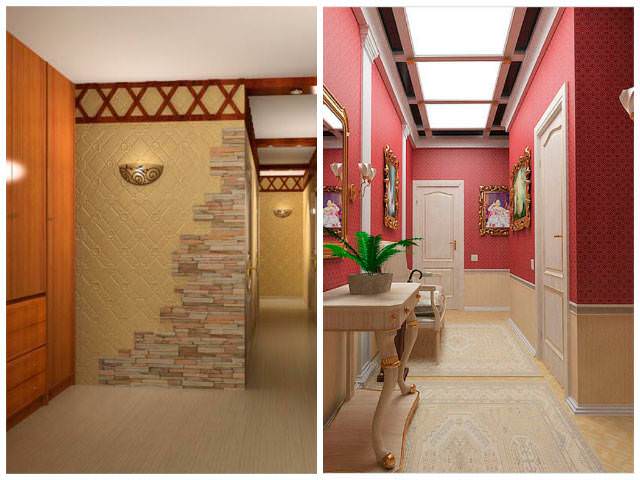
The entrance hall is the first thing that everyone who enters the apartment sees, which means that it would be nice to think about a good finish. Wall materials should combine both practicality and beauty. Ideas and methods of decor can be very diverse, it is important that the selected coating is easy to clean and does not wear out from constant touching with bags, bicycles, strollers, etc. It is better to choose lighter colors of materials, because there are no windows in the hallway, but first things first .
hallway design
The list of requirements for the materials used is not as long as in the case of a bathroom, kitchen or nursery - rooms that require certain conditions to be met. The most important quality that coatings must have is wear resistance. The fact is that even a tiny hallway is the most passable place in the apartment and the maximum load on it. Accordingly, any options for fragile and delicate materials are not appropriate here. The materials must be resistant to accidental mechanical damage so that the claws of animals or metal parts of large objects do not leave scratches on the walls.
The second important requirement is ease of maintenance. Surfaces should not only be easy to clean, but in principle almost not get dirty. The entrance hall is the place where everyone, coming from the street, brings dust and dirt, and in winter also snow, after which dirty stains remain.

There are many materials for decorating the walls of the hallway, and there really is plenty to choose from. When choosing suitable finishes, keep in mind that it should also be in harmony with the overall design of the apartment. The most popular types of wall finishing materials:
wall panels (they can be wooden, plastic or MDF);
The choice of coverage depends only on your imagination, taste and financial capabilities. To better understand which of these is suitable for your hallway, you need to learn more about each of the materials.
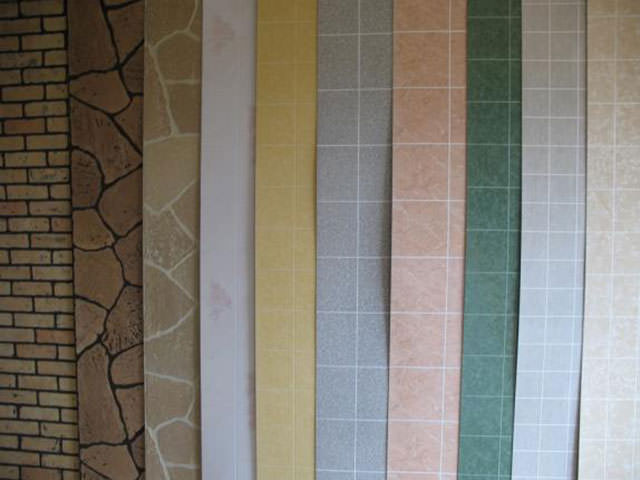
Plastic panels
There is an opinion that paneling is more suitable for office space, rather than apartments, but in reality this is prejudice. On the market of finishing materials there is a wide variety of models made in different colors and differing in different textures. Properly selected materials will look very stylish on the walls of the corridor, giving the room a special atmosphere.
Panels are made of several types of materials - MDF, natural wood or plastic. The last option is the most popular. Plastic is easy to clean, it is not afraid of water and sun, and it is also a bit more affordable than other materials. But plastic panels have a minus - they are not recommended for use in residential areas. It is better to use natural materials for wall decoration, for example, MDF - pressed wood shaving boards, they are much lighter than solid wood. Such material is an excellent sound insulator, and if you purchase MDF panels with special impregnation, they will not be afraid of moisture.
Wood is the most noble and at the same time expensive material for finishing any room. According to its characteristics, wood is stronger and more reliable than MDF. Wall panels made of any material are mounted to a metal crate using self-tapping screws or simply glued to the walls themselves - the mounting options depend on the level of humidity in the room. Otherwise, the installation of panels is simple and does not take much time.
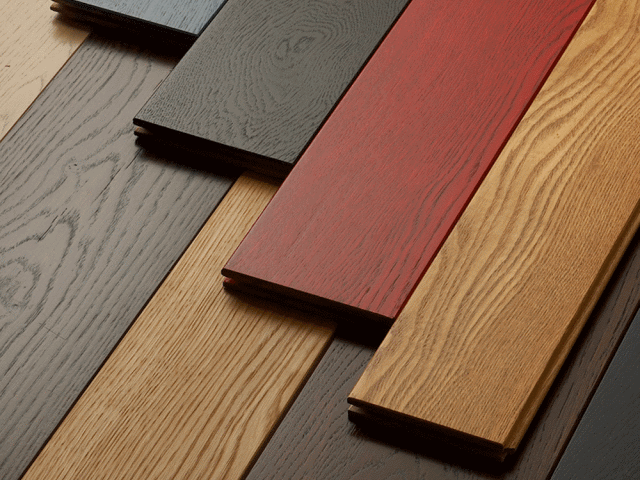
This type of finish is more commonly seen on the floor, however, walls can also be finished with laminate panels. This option in its appearance looks no less chic than natural wood, but at the same time cheaper.
Advantages of laminate flooring:
It is worth considering that the laminate, although very resistant, does not tolerate moisture well, so if the humidity level in the room is high enough, this type of finish is not suitable for the hallway. Otherwise, the laminated coating will be deformed.
Using HPL panels for wall decoration is a good alternative to conventional laminate. Such a coating is resistant to moisture and can withstand temperature changes. During the production of such panels, the material is exposed to very high temperatures, as a result of which it does not delaminate during use. Some HPL panels are treated with a special fire retardant.
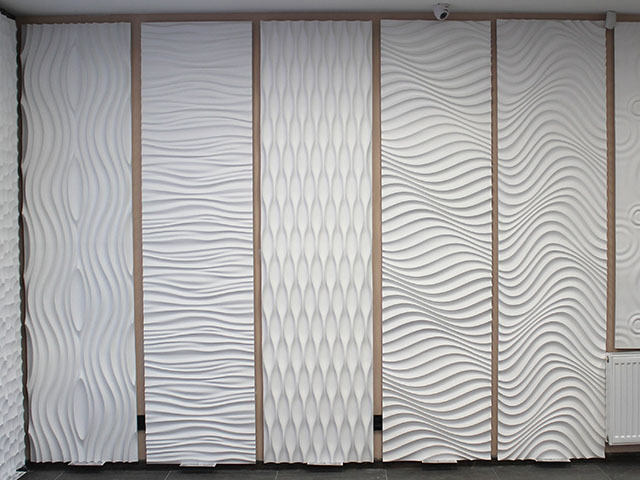
3d panels for the hallway
The use of such material as a finish will require special care. The fact is that 3D panels made of gypsum have a special texture - wavy or reminiscent of air jets. There will be no problems if you decorate only part of the walls with such panels, but if you want to use 3D panels to finish the entire surface, you will need to monitor the alignment of the pattern.
After installation, such a coating can be easily painted in any color, depending on the chosen design of the room. Before painting, the surface must be treated with a primer, but any paint itself is suitable - based on acrylic, latex or ordinary water-based emulsion.
Both of these options are the most budgetary and simple. Paint is the easiest to use, but this type of finish is only suitable if the walls are perfectly aligned. The paint is very easy to care for - all dirt is easily washed off from it. It is best to choose a moisture resistant coating.

Wallpaper paint
Using ordinary paint, you can embody different interior design ideas. The easiest way to diversify the walls is to paint one in one color and the rest in another, or use stencils when painting so that there are various shapes or silhouettes against a solid background.
With the use of wallpaper, there are even more options for decoration - patterns and textures can be selected for every taste and color. Can be combined in one room different types wallpaper, it is only important to choose the right finish for the tone so that the walls do not look clumsy.
Non-woven vinyl wallpapers look best, they are easy to maintain and very durable compared to other types of this finishing material.
Comparing wallpaper with paint, we can say that the first option looks much better and more aesthetically pleasing on the walls. In addition, the wallpaper is quite thick material, which allows you to hide small irregularities in the walls, while the paint will make them even more noticeable.
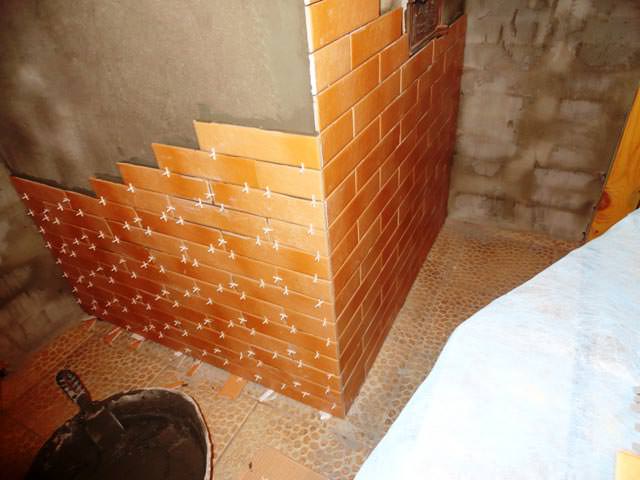
tiling
Ceramic tiles are one of the oldest finishing materials for walls and floors. Tiles are most often finished in the bathroom and kitchen, but for the hallway this is also a good finishing option. The tile can be different in texture and colors, but there are common qualities for all variants of this coating:
Tiled walls will remain unchanged for decades, so you won’t have to think about repairs for a long time (only if you don’t get tired of the appearance of the finish itself). The operational characteristics of the material allow tiling rooms with any level of humidity and temperature. The tile is not afraid of street dirt, it can be easily and quickly washed off any stains.
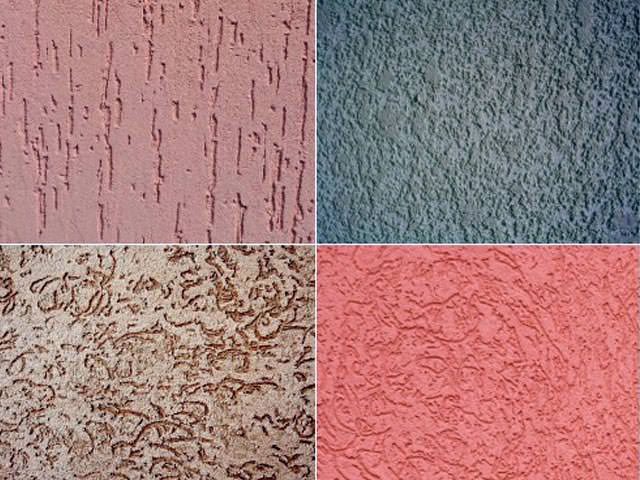
Decorative plaster
This finishing option is able to translate into reality the most unusual ideas. With the help of decorative plaster, you can imitate the most different materials due to the wide variety of colors and textures. Marbled walls will look spectacular.
Advantages of decorative plaster:
Microcement is one of the options for decorative plaster. This material is convenient in that it can be used on any surface - concrete, wood, metal, ceramic or stone. With this type of decorative plaster, you can create different surfaces - matte, glossy, rough or smooth. Moreover, microcement has natural shades, which makes it different from other types of decorative wall coverings. If we compare it with classic decorative plasters, microcement, with the same qualities, is not only cheaper, but also easier to use.
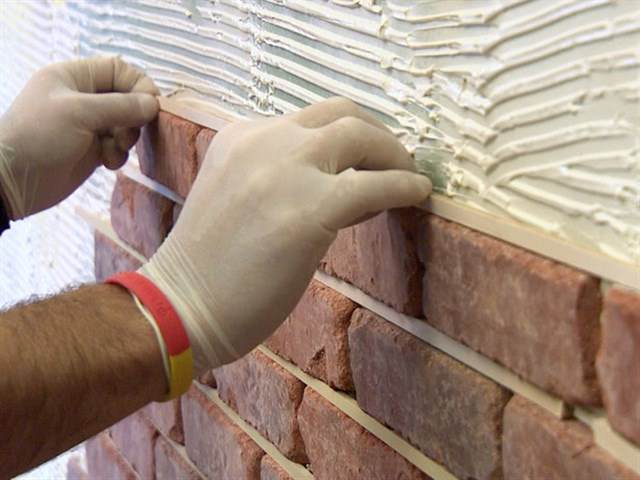
Decorative rock
Of course, we are not talking about natural material - it is not only too expensive for the hallway, but also hard for the walls. For this reason, a lighter imitation of stone from artificial materials is used. Such a coating is also quite expensive, but easier to install. Stones are most often trimmed with some individual details, for example, doorways or arches. If you have ever had ideas about decorating a room like a cave or an ancient castle, stone is just the right option.
In terms of its decorative properties and texture, artificial stone looks like marble, granite, sandstone, limestone, etc. Most often, gypsum is used to produce this material. Advantages of artificial stone as a finish:
It is best to trim the lower parts of the walls with such a stone - this will protect the most dangerous areas from damage.
The frescoes, one might say, are a kind of window into the Mediterranean. This finish will give the room an Italian charm. A fresco is a painting (landscape or some kind of plot) made on the wall. The basis for the frescoes are non-woven or synthetic canvases and the classic version - plaster. Frescoes are often artificially aged in order to achieve a certain visual effect.
One way or another, the fresco is a sign of the delicate taste of the owners of the house. Of course, such decoration is not an option for a tiny hallway; such walls will look best in spacious halls. Regardless of the general style of the interior, you can choose a fresco that matches the colors and design.
Advantages:

Of the minuses, one can note the high cost and the great complexity of the execution technique. First, it is necessary to apply a specially processed canvas to the base, which has previously been given a certain texture, and only then the drawing itself is applied. The final image is additionally covered with a layer of varnish. Without artistic skills and experience, it is impossible to make a decent fresco on your own, but you can mount finished frescoes on the wall. The image is glued to the wall with a special adhesive.
No one can answer this question except you. The fact is that absolutely everything depends on the general idea, your financial capabilities, the characteristics of the hallway. It is worth choosing a material, guided by ease of installation and maintenance, as well as durability and aesthetic parameters. Everything in the apartment should be harmonious.
On a modest budget good options finishes - paint or wallpaper. Paint is the simplest and most affordable material, even if it looks rustic on the walls, but it is easy to apply, economical and easy to clean from any dirt.
Wallpaper is also an inexpensive finishing option, but there is much more room for experimentation. Colors, patterns and textures are very diverse. A hallway finished with laminate or panels is a slightly more expensive interior option.
Finishing with artificial stone or frescoes is more presentable and exclusive, but the materials themselves are expensive and rather capricious.
Tiles as a finish are simpler and cheaper, in addition, there are models that imitate natural stone and brickwork.
Laminate and MDF are a great alternative to expensive natural wood, while such walls will look just as good.
Obviously, any wall material has its pros and cons, and right choice depends on finding the right balance between beautiful appearance, price and durability.
Often people do not attach much importance to the design of the entrance premises (corridor, hallway). Wall decoration in the hallway usually consists of gluing pieces of wallpaper and painting the walls in a solid color. But any room in the house is worthy of attention. And even a corridor can become a canvas for creativity.
Before starting repairs, you need to consider the functionality of the room. Options may vary. The hallway can be used as an intermediary between rooms. If the area of the room allows, then you can place a storage system in the form of a rack, chest of drawers, cabinet. You can hang family photos, paintings or souvenirs brought from other countries on the walls. The design of the future premises depends on these answers.
To understand how to finish the walls in the hallway, you need to answer the following questions:
Finishing the hallway is carried out after the preparatory work. It is necessary to clean the walls and floor in the apartment from the old coating and plaster. All finishes include pre-leveling the surface. This type of work is best left to professionals. If the design provides for wall cladding in the corridor, then you need to lay a metal or wooden profile around the perimeter. Let's take a closer look at what materials you can decorate the walls with.
Wall panels are used specifically for lining the hallway. They are quick to install, easy to clean and cheap. There are a wide variety of color options on the market. The design can be made of slatted, tiled and sheet panels. They look like rectangular bars or squares. For the manufacture of panels, wood, chipboard, MDF, PVC, glass and plastic are used.
As shown in the photo. Often you can find a combined design: the upper part is decorated with wallpaper or painted, and panels are attached to the lower part.
Important! Finishing the hallway and corridor with panels is appropriate only in a wide room, since it takes up an additional 10 cm of space.
You can safely use panels if the design of the hallway is decorated in country style. Light wood in the wall cladding and dark floors will visually expand the space, as shown in the photo. Slatted panels with wood imitation, laid in two tiers, will create home comfort in the hallway.

In order to create a classicist style in the corridor in the apartment, it is worth decorating the walls with moldings or plaster moldings. Embossed (3D-panels) do not need an accompanying decor in the form of personal photos, mirrors, art objects. They also focus attention. This decor is suitable for lovers of minimalism and rigor.
Important! The panels can imitate any surface: masonry, “brick-like”, wooden slabs, porcelain stoneware, mosaic, fresco. It all depends on the financial capabilities of the customer.
Some twenty years ago, the design of the corridor in the apartment was made out only with paper wallpaper. Today, the market has a larger selection of materials: vinyl, non-woven, textile, liquid, cork, linkrusta, photowall-paper, quartz.
The most popular - vinyl. They are easy to clean, resistant to stress, serve for a long time, are cheap, hide surface defects. It is not difficult to choose the best option for a specific design of the hallway in the apartment. But such wallpapers have a serious drawback - they do not allow oxygen to pass through.
Advice! If photos should hang on the walls in the apartment, then it is better to choose a light background for finishing the corridor.
How to decorate the walls in the hallway of a complex configuration? You can create a unique room design with the help of liquid wallpaper. They will help to avoid joints in a room with a large number of arched openings. Wallpaper is easy to stick. There is no need for additional care.
The appearance of the coating depends on which textured finish and paint color is selected.
They contain metallic elements. They are made from porous paper. Sometimes fabric can be used as a base. A layer of thin foil is applied on top. On it, in turn, paint is applied with embossed or patterned. This elegant wallpaper looks very luxurious. In addition, they are very durable. Cleaning the surface does not take much time. The ideas for decorating the walls of the corridor and the hallway with such a coating are shown in the photo.
Important! The surface under the metallized wallpaper should absorb moisture and be perfectly flat. The glue on which they are attached will not evaporate through the canvas. Its structure is very dense.
This type of canvas has the form of a fabric base, on top of which a plastic of natural origin is applied in a thin layer. Usually the last layer is made of gel linseed oil. Wallpaper can be quickly cleaned and painted with water-based paint.
Important! Linkrust lasts a long time, but it is also expensive.
This base will withstand any impact, including pet claws and scratches. On cullets, you can easily apply paint or a pattern through a stencil. You can change the design in the corridor an infinite number of times. The surface is resistant to chemicals. With all these indicators, glass wall papers are cheaper than other modern coatings.
Decorative plaster- This is a material that is used to process walls in the corridor in any color and texture. It creates a durable, "breathable" coating, as shown in the photo. The texture of the pattern depends on the graininess of the mixture and the tool used.

In brick buildings, after cleaning the walls of old materials, you can see the original masonry. This decor can be used in the apartment. The original red brick will not fit into any interior. Therefore, it is washed, dried, and then treated with a special solution or simply painted white. Ideas for decorating a white brick hallway are shown in the photo.
Important! You can also reproduce brickwork using panels, wallpaper or ordinary paint.
The hallway, by definition, is the most accessible place in the house. That is why finishing materials must meet such requirements as practicality and reliability, as well as wear resistance. Otherwise, the beautiful appearance of the finish, which once pleased the owners with its appearance, will quickly come into an inappropriate state.
The repair in the hallway is approached with such care, which is not observed when choosing finishing materials for other rooms: living room, bedrooms, kitchen, bathroom. This is because the premises are used constantly and the greatest activity is observed here.
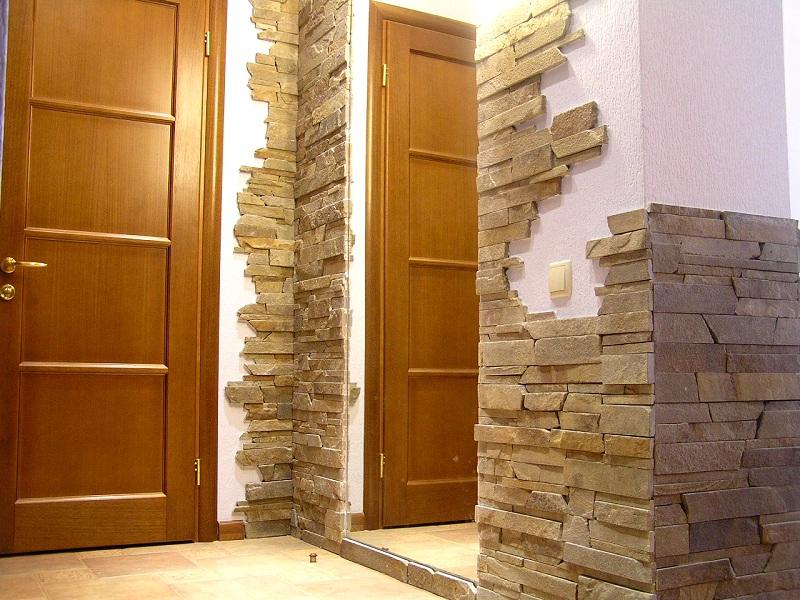
Hallway decoration should be:
In addition, the entrance hall should not be a separate element in the apartment, but must become one with the entire interior. With the availability of modern finishing materials, this is not such a big problem even in this type of room. The most popular options are wallpaper, decorative plaster, wall paneling and painting. The advantages and disadvantages of each material should be discussed separately.
In any room you need to arrange indoor plants. For convenience, they can be located on special whatnots or shelves. Even in the layout of a narrow and small corridor, you need to include a few flower pots to enliven the room.
The most popular material for finishing any room, which ordinary consumers prefer, is wallpaper. In any apartment at least in one room you can find glued walls. Of course, they have many advantages, but sticking paper wallpaper in the hallway is not practical. Their coating is too unstable to mechanical stress. This means that ugly damage to the surface will not keep you waiting.
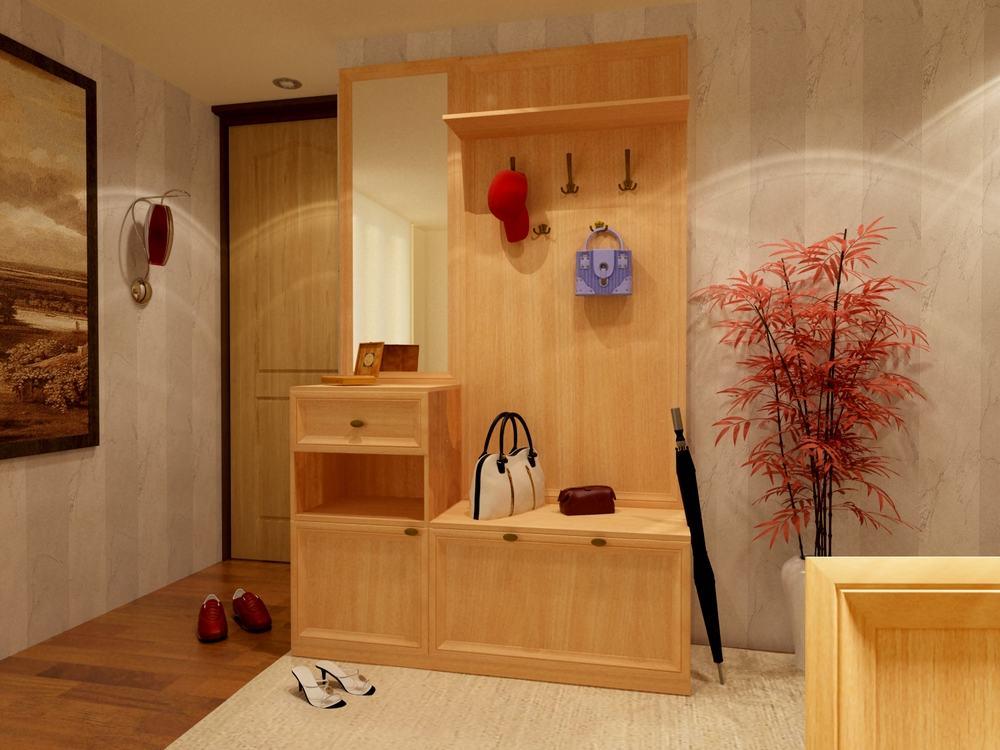
For the hallway suitable wallpaper:
To all the above points, you can also add glass wallpaper, which is highly wear resistant. They are able to withstand even the onslaught of cat claws without surface deformation. And beautiful and graceful textures can revive even the smallest hallway.
Glass wallpaper is easy to paint. Due to the noticeable relief texture, the painted surface will look very original. Increased attention from guests to such wallpapers is guaranteed.
Decorative plaster is an interesting and unusual solution for the hallway. All this is because by combining several techniques in applying the material, you can achieve a unique design. And the cost of this type of finish will please consumers with different financial capabilities.

You can decorate the walls in the hallway with decorative plaster with the following effects:
The increased strength of decorative plaster to mechanical stress becomes a decisive factor in the choice of material for finishing the hallway. The design of the room will immediately change and sparkle with new colors, thanks to the opportunity to experiment and achieve unique patterns on the surface. Even an uneven wall can be beautifully transformed with decorative plaster. You just need to stock up on materials and start implementing ideas!
With the help of masters working with decorative plaster, you can create truly unique ornaments or images on the walls in the halls. Professionals are able to finish the surface taking into account any wishes of the client.
The most popular type of decoration (and not only for the hall) is plastic wall panels. They are easy to install: several people can install a medium-sized room during the day.
Plastic panels are easily deformed in case of severe damage, but leave deep scratches on the surface is quite difficult. As far as we know, they break only under point loads.
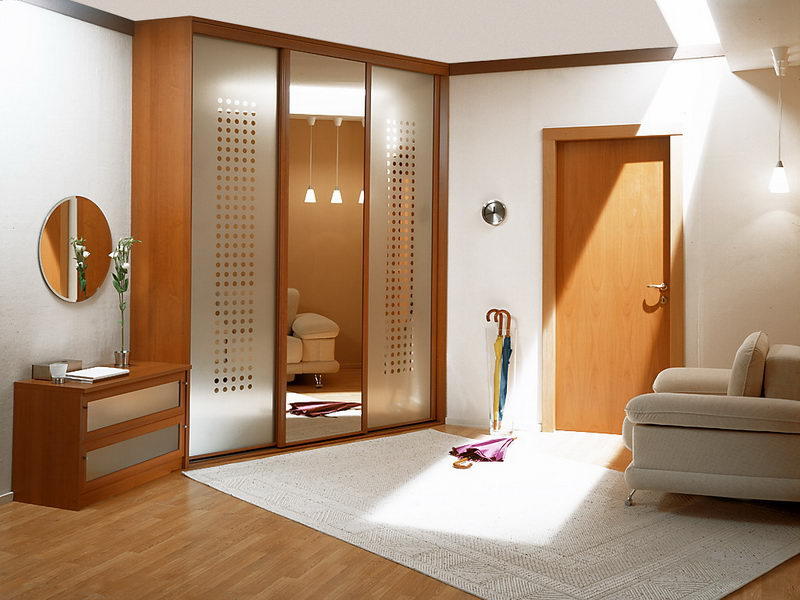
Manufacturers give a guarantee on the material - 15 years, but according to consumer reviews, they show themselves with better side enough for a long time. In addition, during the entire period of operation, they retain their impeccable appearance and do not fade under the influence of sun rays. Finish with such panels, as a rule, rooms with high humidity: baths, bathrooms.
The colors of the wall panels presented in the assortment of stores:
Thanks to such a wide variety of colors, wall panels fit perfectly into any decor. The only caveat is the need to build a frame. It is needed to tightly fit the panels to the structure to ensure a flat and smooth surface without bends. But doing it yourself is not a problem.
Are very popular plastic panels with wood imitation. Such a pattern on the surface allows you to create a real illusion of a natural texture, but at a low cost. As for the use of wooden boards, this is impractical and short-lived: the surface is too susceptible to damage.
Any person, before thinking about repairs, is determined by the color scheme of the room. And only then he selects finishing materials for his preferences to recreate his idea. An inexpensive and quick way to finish the hallway is to paint the walls.
In order to start the transformation, it is necessary to level the work surface. To do this, you can use plaster and putty, but for this you need to hire workers. It is best to finish the walls with drywall, having previously built a frame. Its even canvas hides all the flaws of the wall, including ugly corners. In addition, there is no need to remove the old lining: the supporting structure can be erected directly on the old wallpaper or paint.
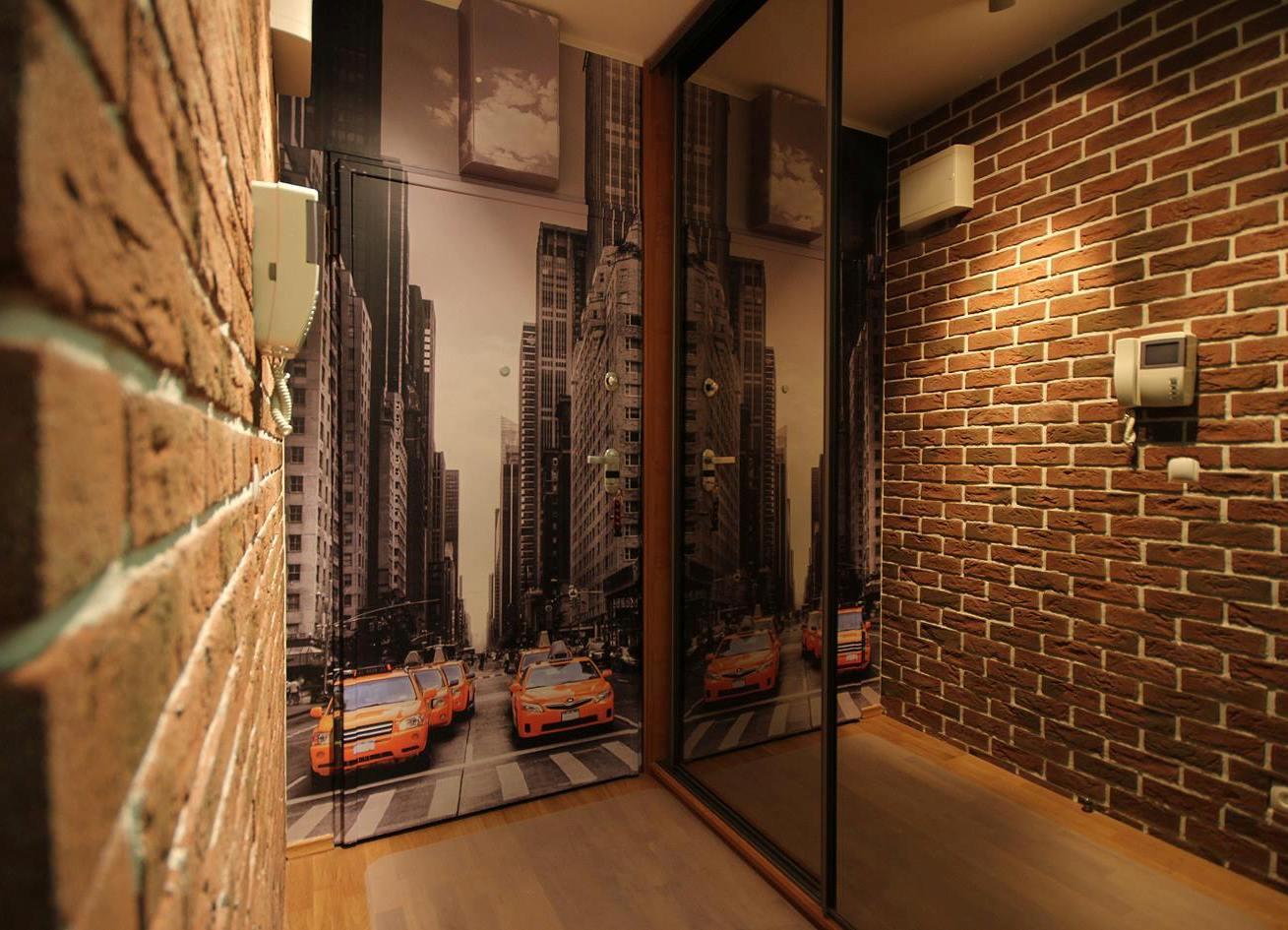
Before choosing the color of the room, you need to remember that the paint must be on water based for easy maintenance. In case of the wrong choice, it will be impossible to wash or wipe the walls.
Water based paint:
But you should not limit your imagination in one color and make the hallway monophonic. Experiments will allow you to create a unique design every time, unlike the last time. And the predominance of combinations in the corridor will help make it more interesting. The most optimal option from the point of view of designers is to paint two adjacent walls in one color, and the rest in another.
In any room, when decorating, it is better to give preference to light shades. They visually expand the room and favorably affect the mind, rather than gloomy and overweight colors: black, brown, dark blue, purple. Even the small height of the room is played up with light shades. The recommended ones include: blue, green, pink, beige, mint colors.
Mats with longitudinal lines are used as an additional element for the hallway. In the people they are called a path. Full carpets, located around the entire perimeter of the room - this is not fashionable. Now it is customary to use small paths in the interior, which are located everywhere and protect the feet from the cold floor.
There is no single answer to the question of what material to choose as a finish for the hallway. You can decorate the walls with anything, but taking into account such indicators as reliability, practicality and durability. The methods presented in the article are the most popular and recommended. You just need to peep a couple of design options and, based on the photos you have viewed, proceed to implement the most daring ideas.
It would seem that one can fantasize in these small-sized, as a rule, cramped rooms. But since it is the hallway that creates the first impression of the whole house and sets the tone for the design of the entire interior as a whole, it is extremely important to properly organize the space and optimize literally every detail of this segment of the apartment in order to create a warm, friendly and at the same time functional atmosphere. To do this, you must adhere to several basic principles.
Hallway Design - Ideas and Tips
When choosing the color of the walls for the hallway, it is better to start with light neutral shades. A gradual transition to darker tones as you move deeper into the hallway will place the necessary accents and create a contrast with the base color. For rooms with perfectly smooth walls, a glossy finish texture is perfect. It will visually expand the space, thanks to the reflections from the shiny surface.
If your hallway has simple, smooth walls, then it is recommended to use false panels and moldings to add variety to the interior and break the feeling of monotony. Simple moldings and cornices, framing the upper and lower parts of the walls, will add relief and emphasize the sophistication of the hallway decor. Doorways are recommended to be decorated with solid frames, which will emphasize the architectural style of the hallway and give the interior a geometric look.
Hallways, as a rule, do not have natural light sources. Therefore, in these rooms it is recommended to use wall lamps, sconces and chandeliers. Additional light sources will not only create a cozy atmosphere in the hallway, but also visually expand the narrow hallway. An important detail of the hallways are wall mirrors, the reflections of which create the illusion of continuing into the depths of the space and add light.
Many underestimate the importance of decorating the hallways with paintings and art objects, but it is extremely important that everyone who enters the apartment from the very first steps plunges into the atmosphere of beauty and feels the individuality of the owners of the house. For this, personal photos in stylish frames are perfect. Modern prints can also look beautiful on the walls of the hallway. On small shelves, you can place art objects, figurines, old books or music boxes that tell about your hobbies or about the history of your family.
Hangers for outerwear and bags help keep the hallway in order. A combined stand for coats and umbrellas is also an indispensable attribute of the hallway interior. Since there is no extra space in the hallways, each piece of furniture should be multifunctional. So, a small cantilever bedside table for keys and bags can be simultaneously used for sorting correspondence, and a compact shoe cabinet can serve as a chair.
Indoor plants coexist perfectly in the hallways, enlivening the atmosphere and giving the interior a more attractive look. Hanging flowerpots can be placed at the corners of the hallway, emphasizing the architectural features of the room.
It is extremely important to remember that the entrance hall is the face of the apartment, so the design elements of the hallway should overlap with the overall style of the interior design as a whole. If possible, it is necessary to choose furniture that is similar in style to the situation in adjacent rooms. The hallway palette does not have to exactly repeat color scheme apartment, however, it must comply with the overall design concept, creating a sense of unity and thoughtfulness of the interior as a whole.
Paint the hallway walls in light or warm colors such as white, cream or yellow. These colors reflect light, visually expanding long and narrow spaces.
Accentuate the end of the narrow hallway, highlight it by painting the doorway and the door itself in a darker color. Then the hallway will seem shorter. If in force architectural features Since there is no doorway in the hallway, you can place a large picture at the end of the hallway, install a figurine or other piece of art.
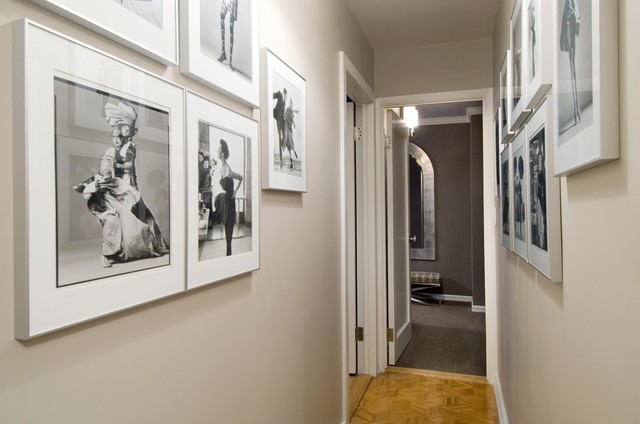 Design of a narrow hallway in an apartment
Design of a narrow hallway in an apartment 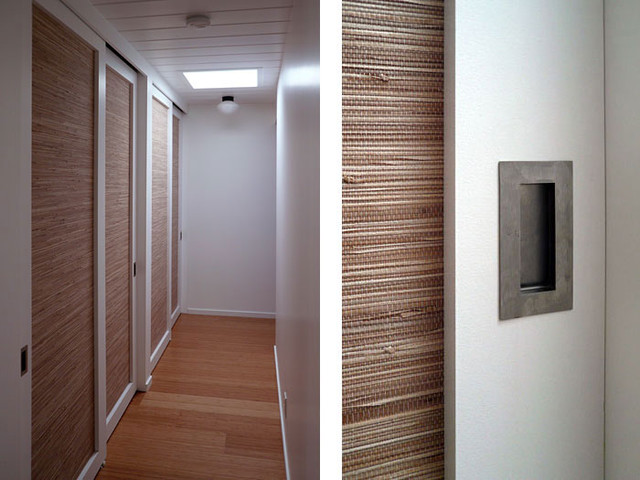
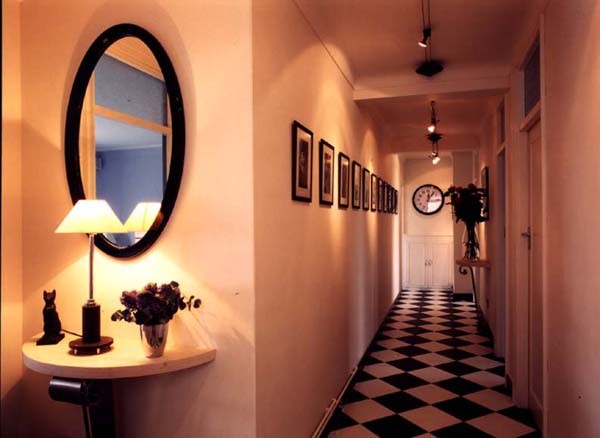
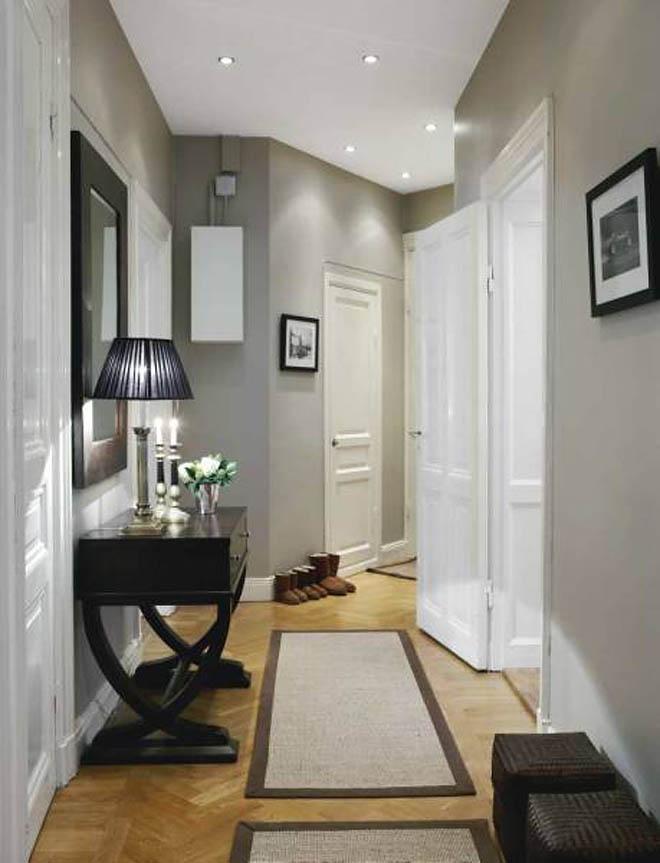
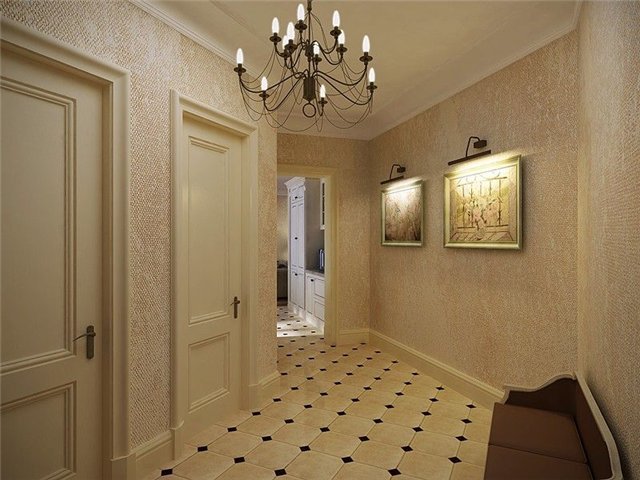
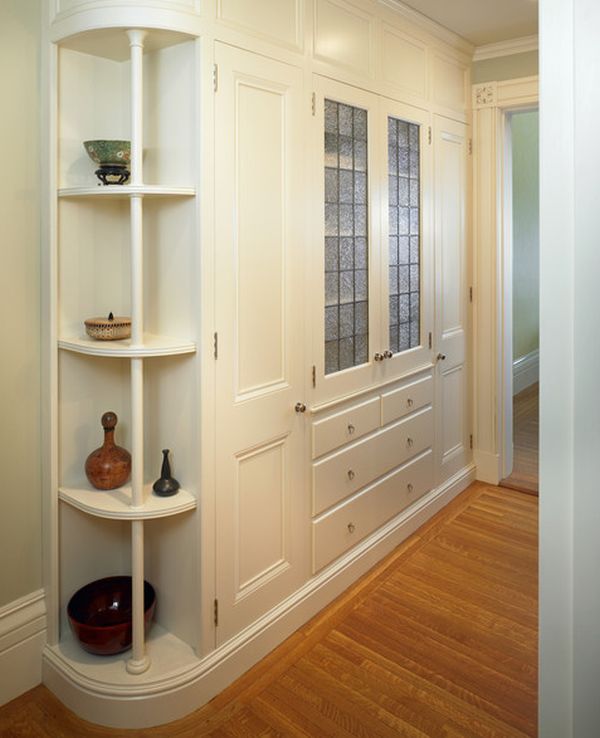
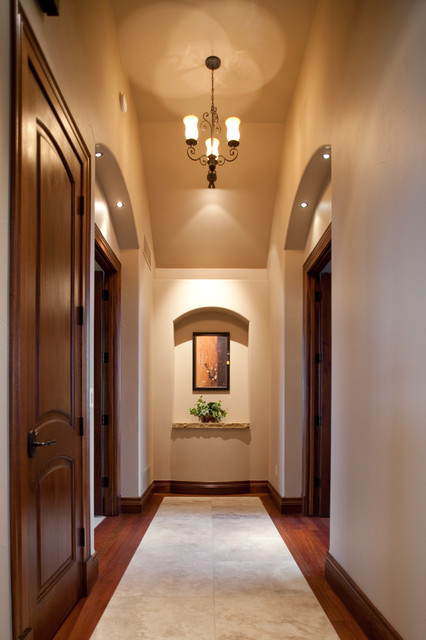



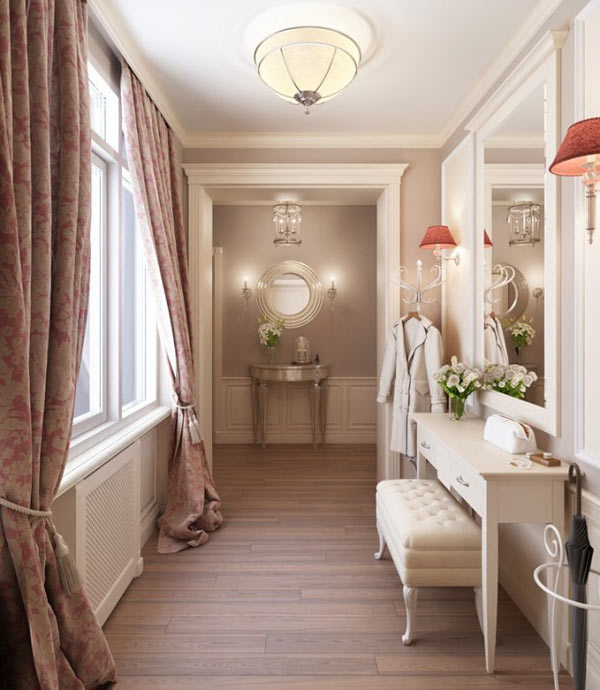
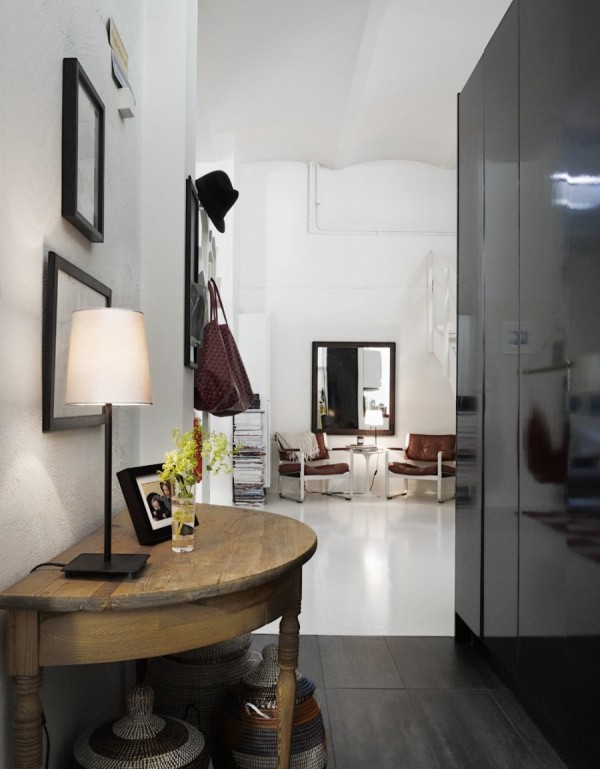
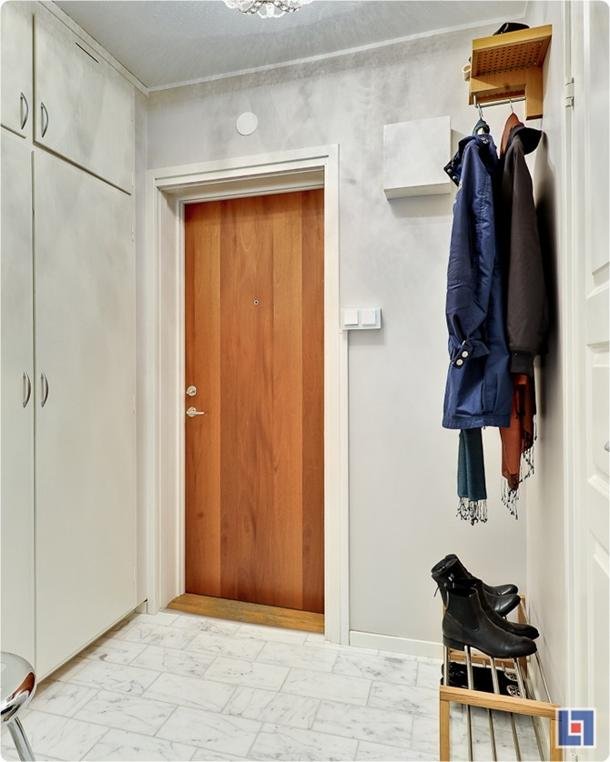
If you are lucky and you have a square entrance hall, then it can be equipped both as a place to store street clothes and shoes and as a place to meet guests. God is in the details, the French said, and in the square space of the hallway, every detail should be thought out and functional. Pay special attention to accessories. A key hanger, houseplants that greet you with their freshness and natural elegance, scented candles with your favorite scent, and even a vase in which you keep change for tipping pizza guys - everything should be thought out as much as possible in accordance with the design concept of the idea of the apartment as a whole. .
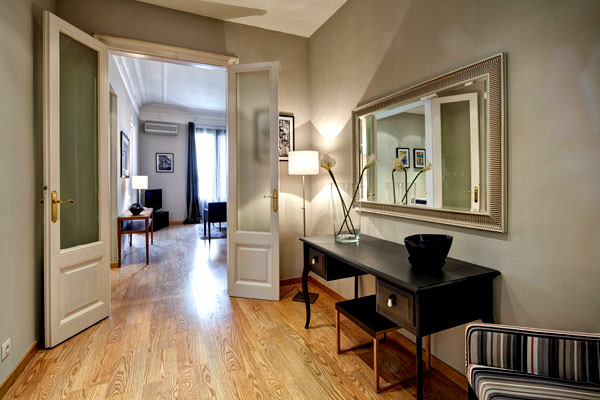
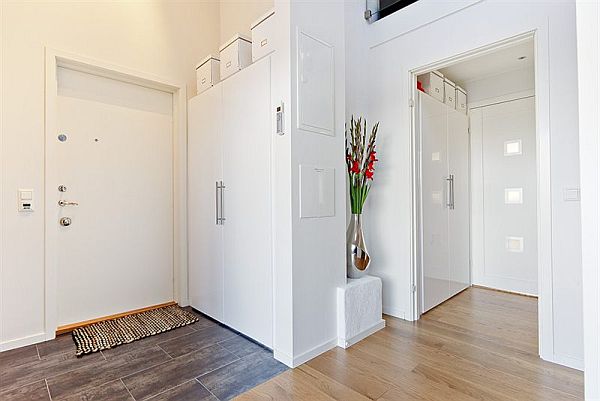
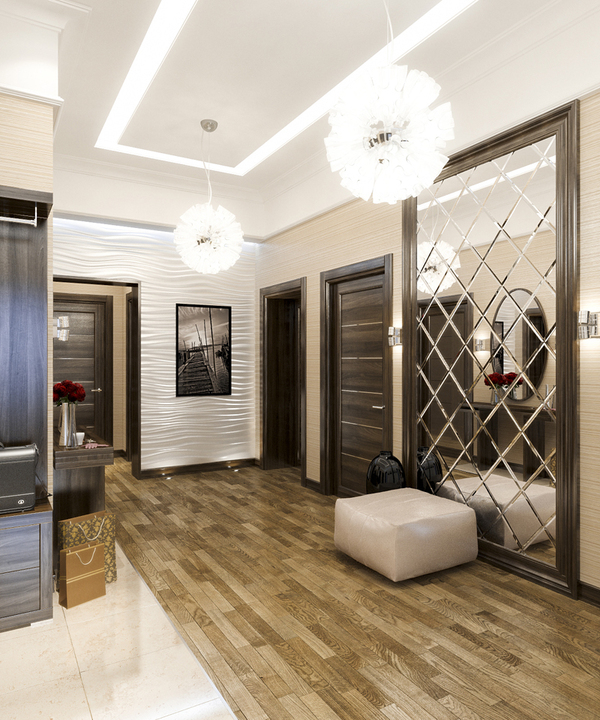

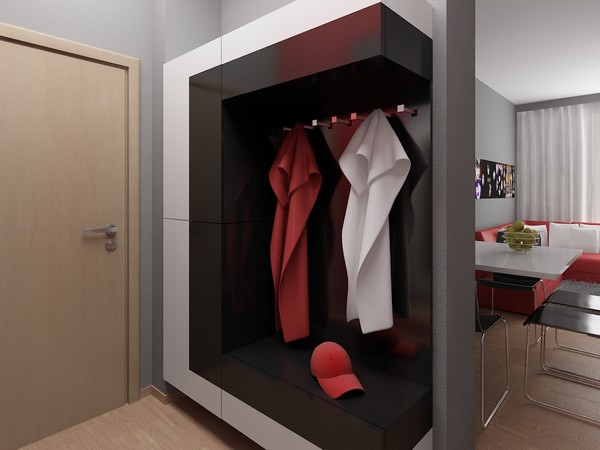
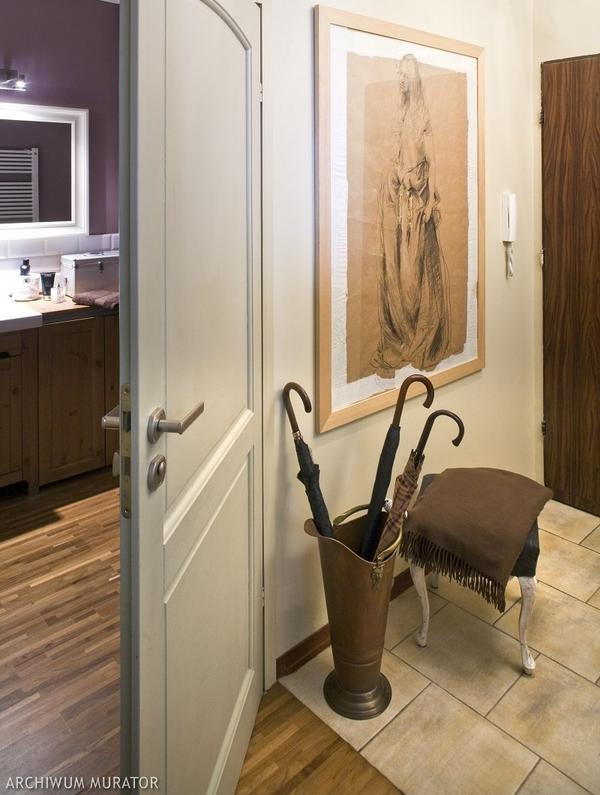
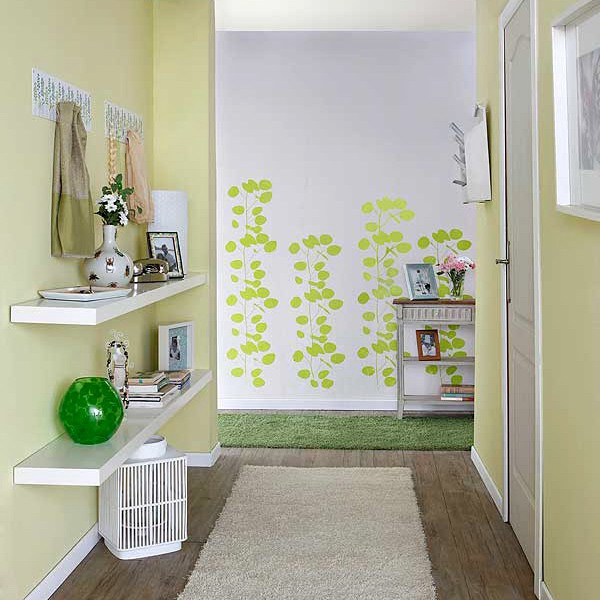
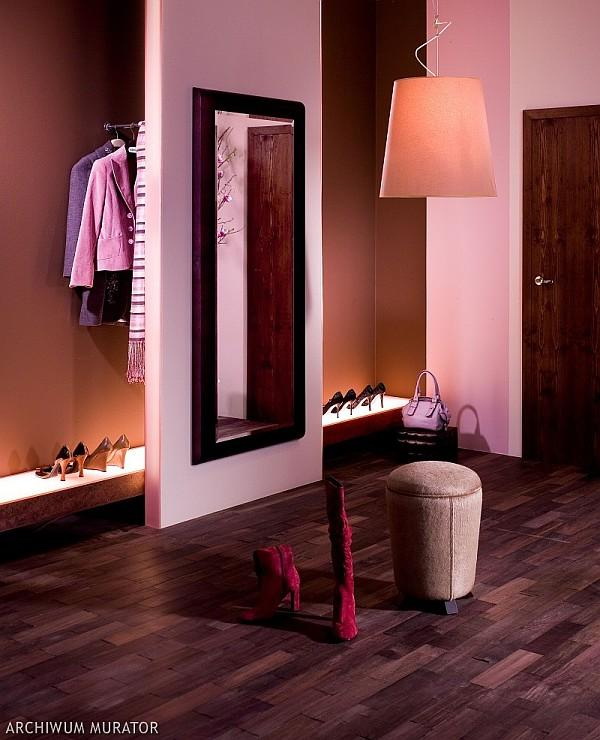
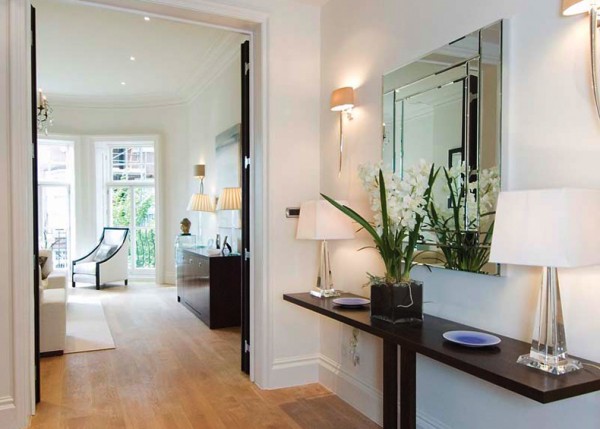
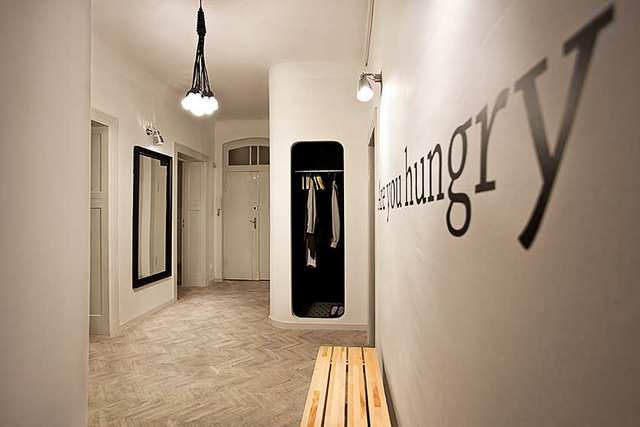
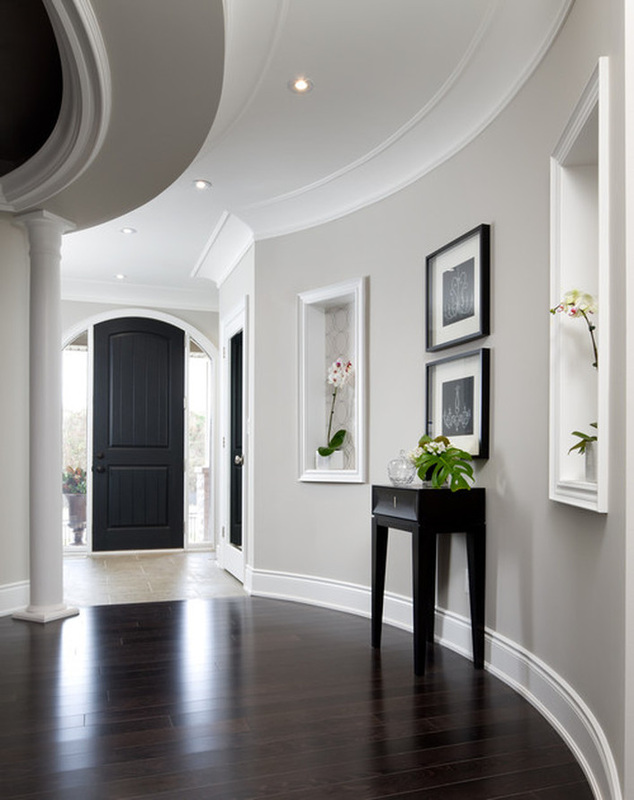
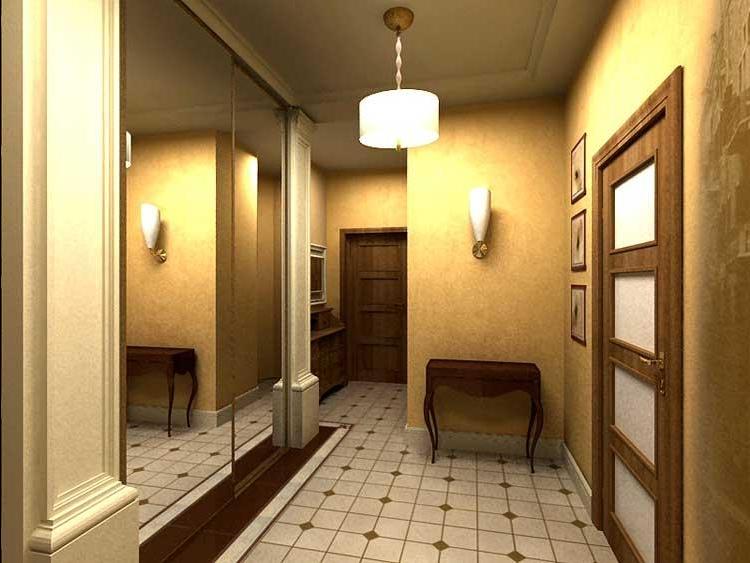
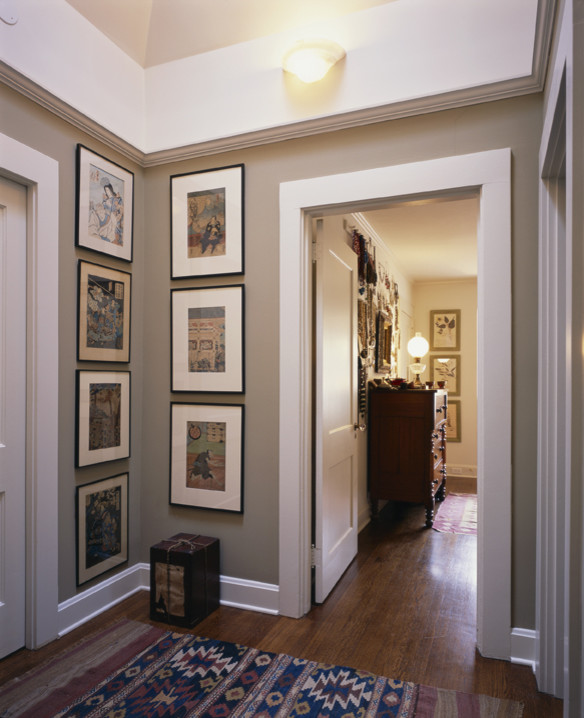
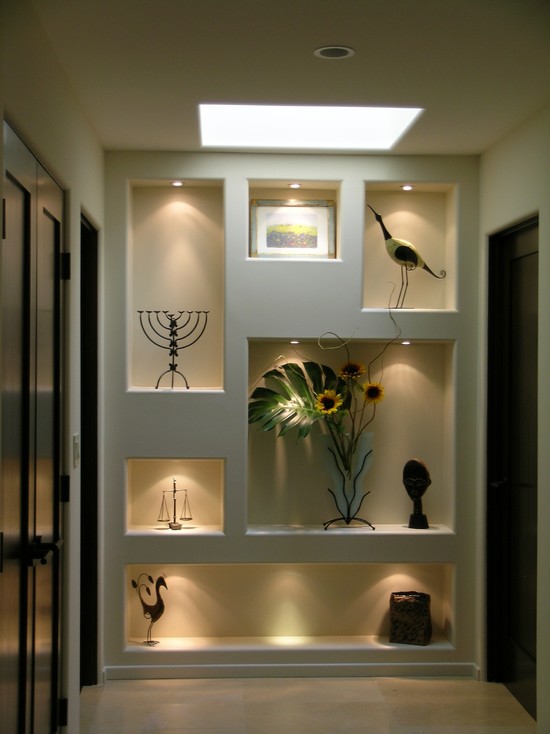
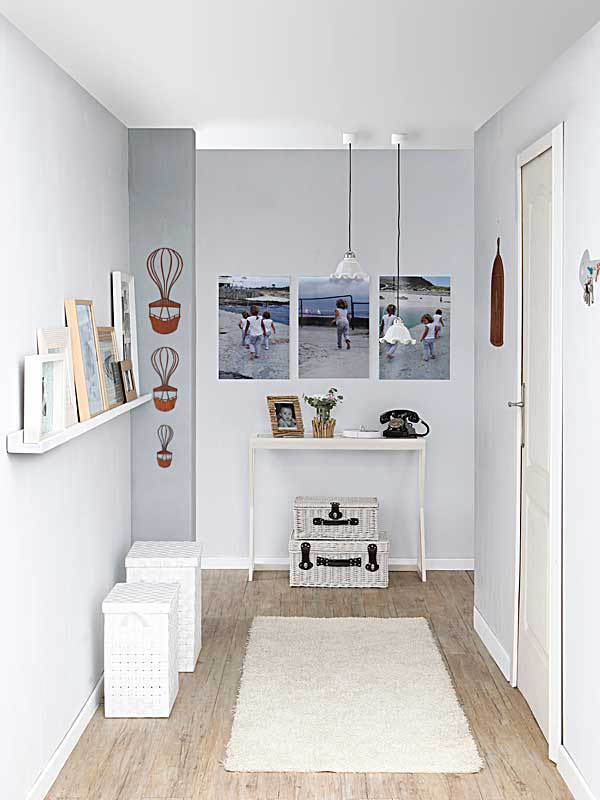
The entrance hall and corridor are auxiliary rooms, but they require no less attention than the main premises of a house or apartment.
After all, the entrance hall welcomes you and your guests, inviting you into the house, and gives an idea of what to expect next.
You should not treat this room with coolness, the theater begins with a hanger, and a dwelling with a hallway.
Filling the hallway with functionality, take care of the beauty of the room, its practicality, since a large number of modern building and finishing materials allow you to decorate the hallway and corridor for every taste and budget.
A few tips for arranging the hallway and corridor
Finishing options for the hallway and corridor
In apartments and houses in the style of minimalism, the walls of the premises are often painted with waterproof and wear-resistant acrylic paints after their preliminary leveling and puttying.
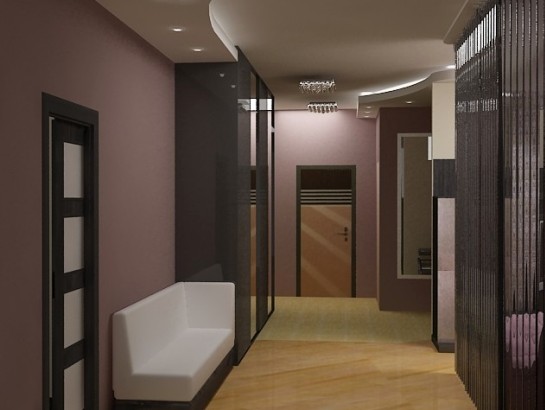
The color scheme is individual, but usually these are neutral light shades that serve as a backdrop for darker doors and door frames, as well as furniture.
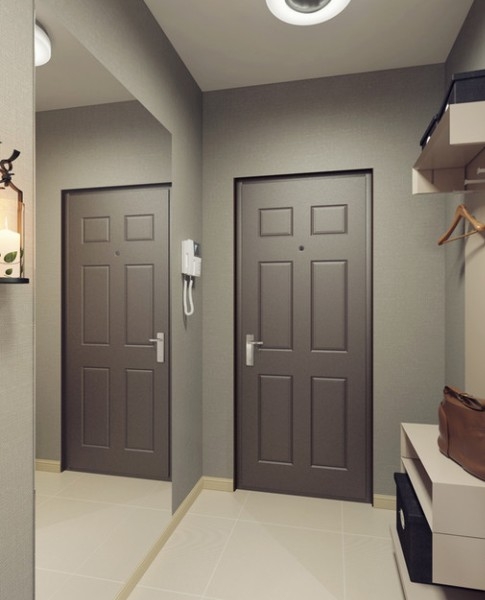
Wall painting can be combined with photo wallpapers or decorative stickers, which will greatly enliven the interior.
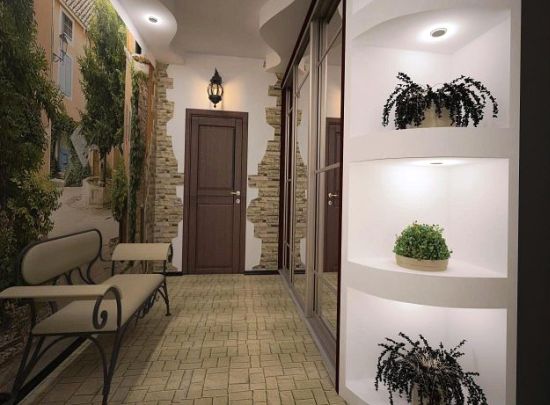
Wall decoration with decorative stone in the hallway, artificial or natural, in combination with painted or plastered walls looks very original. The corners of the corridor and hallway are protected from chips and damage. The stone can be matched to match the main walls or tiles can be laid in contrasting shades with respect to the walls.
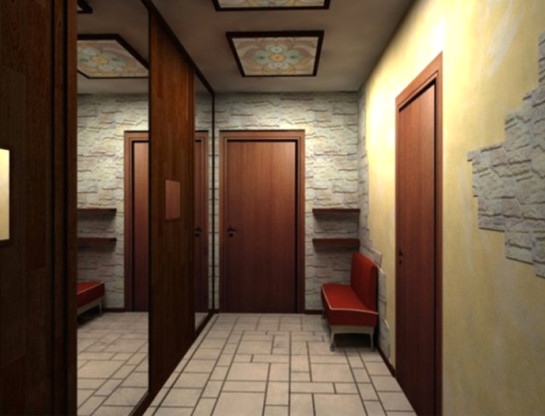

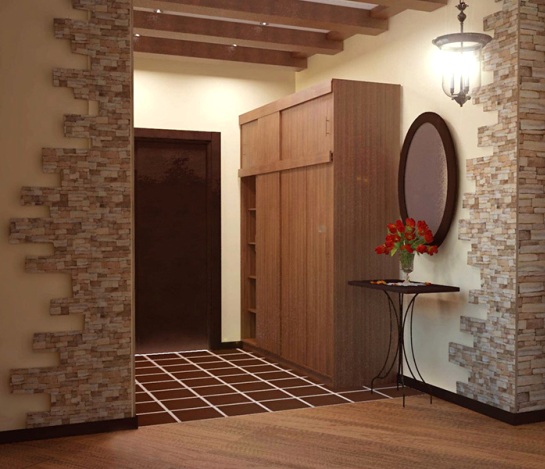
Decorative brick also looks good in the interior of the hallway, the light shades of which will help expand a small room.
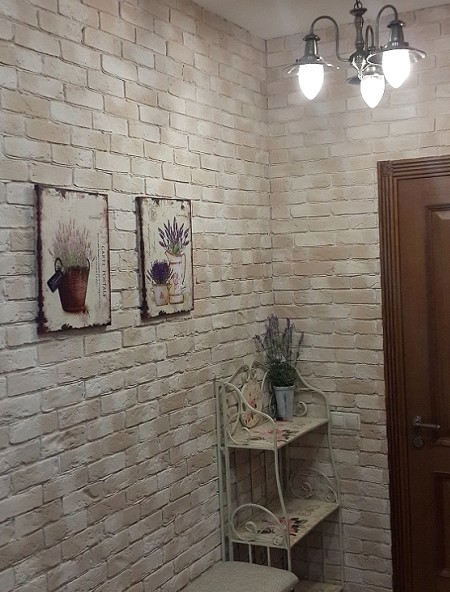
Decorative plaster is a very functional type of finish for hallways and corridors, as it is less prone to abrasion and damage, the walls can be cleaned of dirt and dust with a brush and washed with suitable detergents. In addition, decorative plaster itself looks very effective in the interior of the hallway.
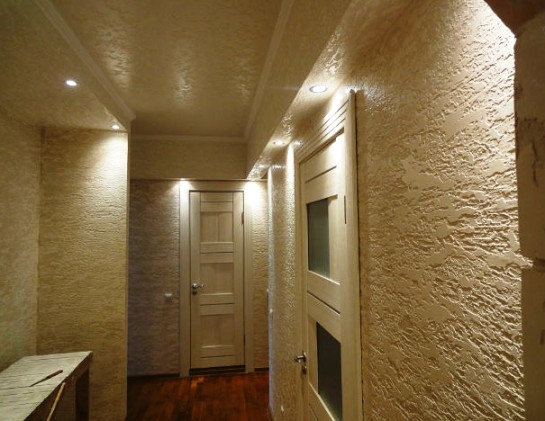
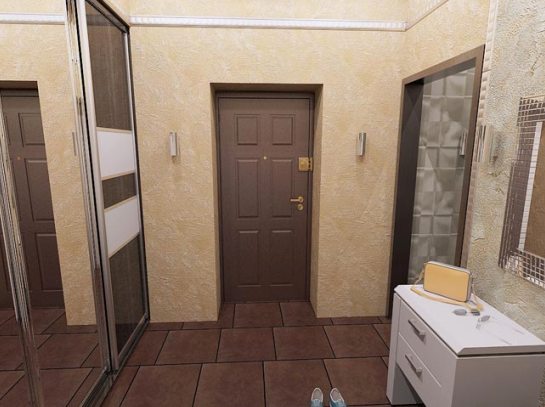
Another way to finish the walls in the hallway is decorative panels made of natural wood or MDF, as well as a more budgetary option - PVC. This finish is suitable for a classic interior, and for an interior in a vintage, Mediterranean style. Usually, only the lower part of the walls is decorated with panels.
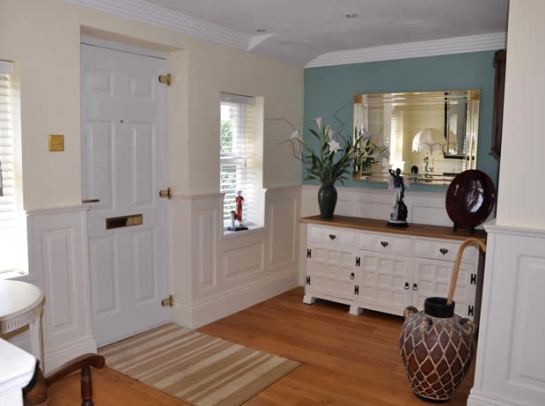
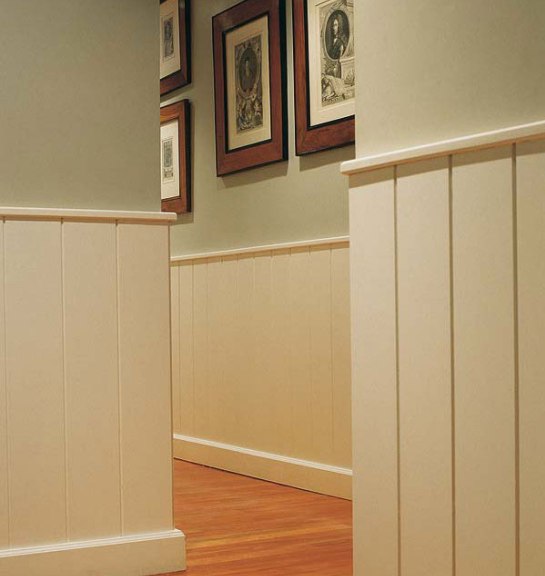
The walls can also be decorated with a board or clapboard, which, if necessary, is painted in the desired color. Vertically arranged boards visually "raise" the ceiling, horizontally - "expand" the walls. This solution will harmoniously fit into the interior of a wooden house.
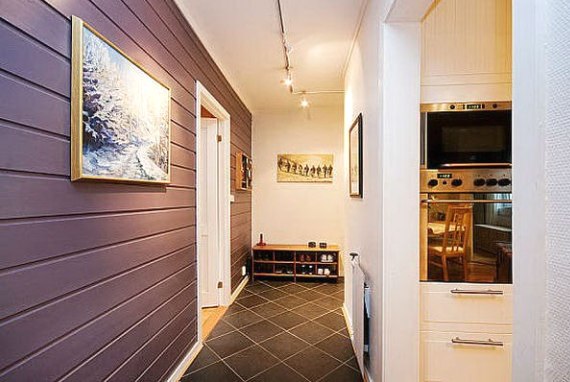
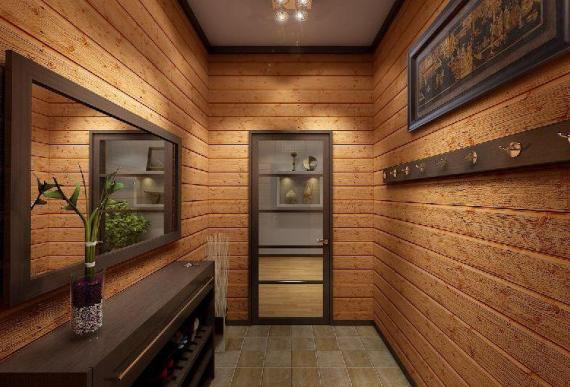
Wall decoration in the hallway with wallpaper is less effective, as the wallpaper wears out and gets dirty more easily. However modern views This material (moisture resistant, washable) is used in the hallway and corridor. Any type of wallpaper can be combined with various materials (panels, stone, tiles).
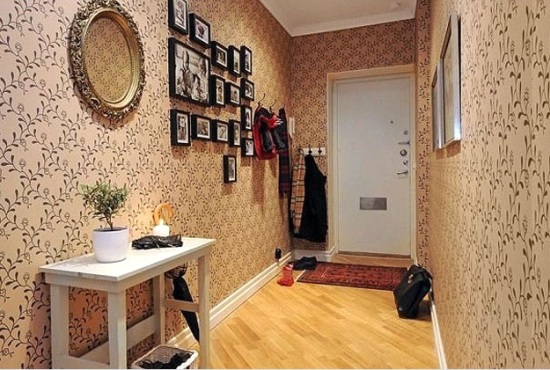
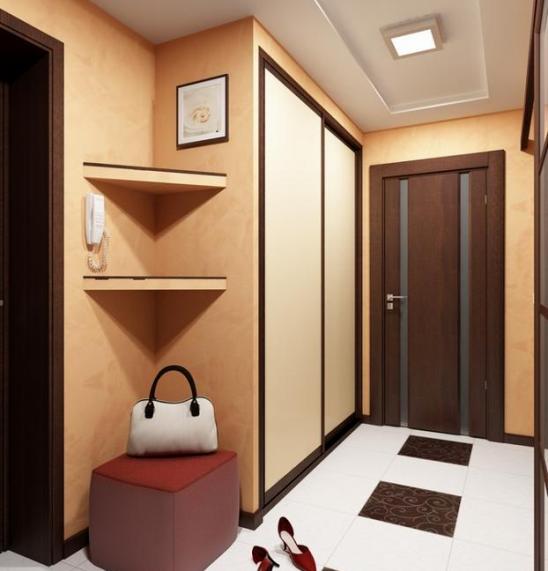
Hallway floors are best decorated with moisture-resistant materials, such as tiles. If the floors of your house are lined with laminate or natural board, then for an integral perception of the interior in the hallway, you can pick up wood-like tiles of the same shade as the main floor. Laminate and parquet are not suitable for a hallway, as moisture and dirt brought from the street will quickly damage them.
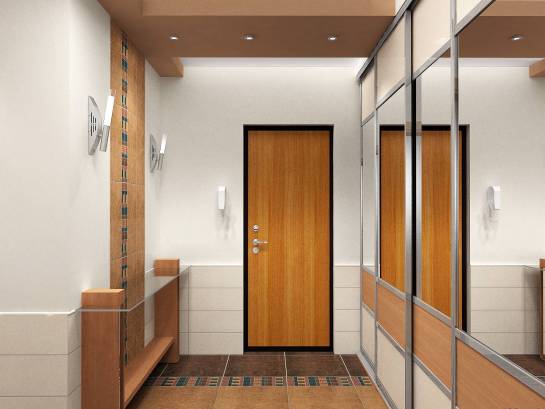
As a moisture-resistant material, a polymer self-leveling floor is suitable. Such a floor is resistant to abrasion, scratches, impacts, chemicals, durable, beautiful, and easy to care for. There are many options for self-leveling floors: matte, glossy, plain or patterned. Everyone can choose the option that is acceptable to the chosen style of interior.
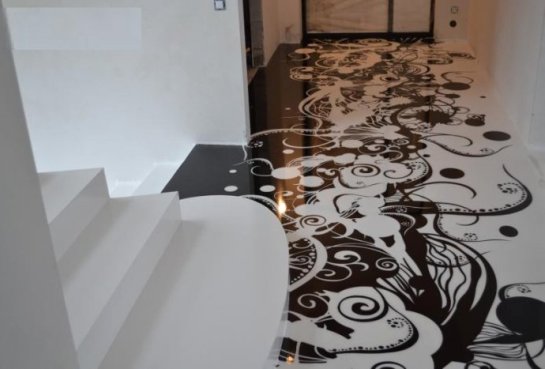
Pay no less attention to the hallway than to the rest of the premises of an apartment or a private house, and then the interior of the home will become solid and will delight you for many years. beautiful hallway will meet you in the evenings when you return home and see you off in the morning, setting you up for a good day.